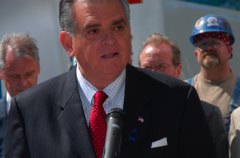
capitol of our country.”
(Photos © J. Maus)
In a show of political support the likes of which I’ve never seen, a host of elected officials were on hand this morning to welcome U.S. Department of Transportation Secretary Ray LaHood to Portland. They assembled at the base of the Aerial Tram (with tons of bikes parked everywhere) to cheer on Portland’s fast-moving streetcar plans and to unveil a prototype of the first streetcar to be made in America in nearly 60 years.
Speaking to the crowd, LaHood made it clear where he stands:
“I came here today because Portland is the transportation capital of our country, Portland is the green capital of our country, Portland is the streetcar capital of our country, and Portland is, the livable community capital of America!”
(That line went over so well, LaHood repeated it again at the end of his speech.)
LaHood lauded the fact that public transportation has been “part of the DNA here” for decades. “It’s difficult to imagine greater Portland,” he said, “without streetcars, light rail, and buses to take commuters and tourists almost anywhere they need to go.”
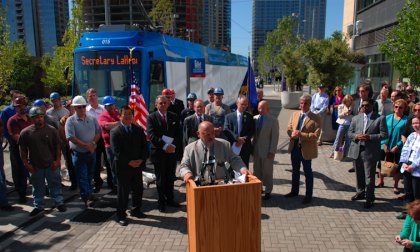
It was a day for hearty congratulations and optimism and pats on the back. Rep. Peter DeFazio called federal money set aside for Portland’s streetcar projects, “a great example of a good earmark.”
Governor Ted Kulongoski piled on the green excitement by calling his recently passed Jobs and Transportation Act of 2009 “the greenest” in Oregon’s history (despite the fact that it was roundly criticized by environmental groups, gives only paltry consideration to bicycles and has $900 million worth of highway project earmarks).
Congressman Blumenauer was very excited to have LaHood’s support for streetcar and livable communities. He praised LaHood for being able to figure out in four months, “what the Bush administration couldn’t figure out in four years.”
Also during his speech, Blumenauer said the event, “Celebrates the nexus of how our community has approached livability, transportation, land use and empowering citizens.” He also pointed the adjacent LEED Platinum building and “bicycles all over the place” and said the location of the event “highlights what we’re all about.” (He also referred to George Will as “goofy” for his criticisms of LaHood and Portland).
After the speeches, the dignitaries took a ceremonial first ride in the new streetcar.
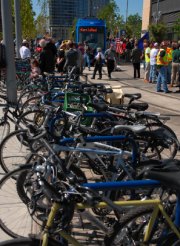
I came to this event knowing it wouldn’t offer much in the way of bike news, but I wanted to see first-hand what it’s like for a non-highway transportation mode to garner so much mainstream political attention.
An event like this — only with a bike funding project announcements and a new, “Made in USA” bicycle in place of the streetcar — should be the primary goal of every bike advocacy group in the nation.
I agree with speakers that the event signals a “new dawn” (or more accurately a re-dawn) for America’s transportation future, but I wonder where bikes fit in. It’s growing ever more clear that our historic allegiance to cars and highways is on the wane (slightly), and it’s also very apparent that streetcars and light rail trains are masterfully seizing the opportunity to feast on the federal funding trough in their place.
I have a lot of questions about this enthusiasm for streetcars. At what cost do we reap its reported benefits (construction and ongoing operations are very expensive) relative to costs to aggressively promote bike usage? Will their presence degrade the quality of the bikeway network? What mode — bikes or streetcars — have the highest return on investment? Are streetcars a viable mode of transportation or are they primarily a tool to spur new development? How will bike projects compete against streetcar projects for non-motorized transportation funding?
As the shiny new streetcar rolled down the tracks for the first time, stuffed to the gills with Sec. LaHood and just about every major politician in our region (except for Mayor Adams, who was likely in a City Council meeting), I couldn’t help but notice the irony that there was a major lack of bike parking capacity to service the nearby buildings.
Let’s hope that, in this moment of cheerleading for livable communities and excitement for funding green transportation modes, the interest from politicians to seriously invest in our bikeways doesn’t just roll on by.
— More coverage of today’s event on the Portland Mercury blog.


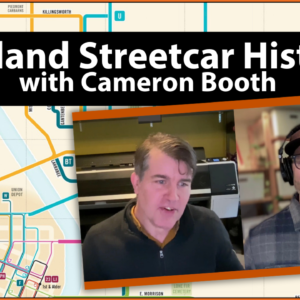

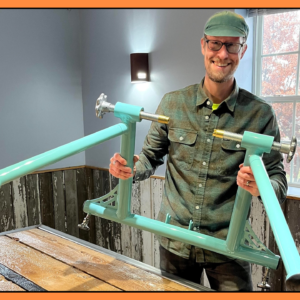
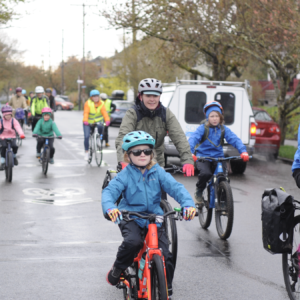
Thanks for reading.
BikePortland has served this community with independent community journalism since 2005. We rely on subscriptions from readers like you to survive. Your financial support is vital in keeping this valuable resource alive and well.
Please subscribe today to strengthen and expand our work.
Yes, I drool over the pot of cash spent on the streetcar (and MAX, etc.) compared to bikes.
And yes, streetcars are indeed a development tool, not just transportation. They can’t move people any faster than buses, but they exert far more powerful effects on the neighborhood.
Consider though how the effect of promoting higher density can encourage more cycling. After all, most people aren’t likely to bike long distances… but draw shops and jobs and housing together along streetcar lines and more people will see a bike as a useful mode.
Just look at the number of bikes in the Pearl. The streetcar can’t claim all the credit, but it contributed.
good write-up, but i didn’t understand this line:
An event like this, but with bike funding announcements and a new bicycle in place of the streetcar should be the primary goal of every bike advocacy group in the nation.
also, i consider streetcars to be ‘motorized transport’ (thus, I didn’t think streetcars could qualify for ‘non-motorized transportation funding’. am i wrong?).
to me, the streetcars are a necessary evil at this point. yes, they’re ridiculously expensive to build and operate, dangerous to bicycles, but on the whole, to achieve the modal shift to things non-car (by far, the worst evil, imo), streetcars/light rail/etc. are necessary. it’s definitely something us bike/walk folks should not let get lost — that is, how awesome walking and biking are compared to everything else — for the reasons you mentioned and myriad others.
This makes me sick. First streetcar in 60 years?! New Orleans built 24 streetcars. They then rebuilt those 24 ADA compatible streetcars after Katrina. The total original price of the 24 streetcars was less than what Portland got their original foreign made streetcars. The New Orleans cars have more seating capacity, slightly less “crush capacity”…
PLEASE, get this straight. All this BS about Portland’ friggin hand built streetcar built by an X-Soviet block state corporation at almost 3x the amount we could have built then in country by Americans is disturbing.
Don’t get me wrong, I dig streetcars, but Portland’s is by no means a great acheivement, unless you’re trying to bankrupt a city. Little Rock, New Orleans, Memphis, Houston, Tampa are ALL cities that have had streetcars, most have MORE streetcars and multiple miles of tracks. All the while, each of those cities have spent 1/5th to 1/2 of what Portland has spent for less service, less capacity, and less quality.
I’m not against streetcars, but bragging about the most expensive, lower quality, fancy because it’s “shaped different” is just preposterous. It would be great if they ran & built the streetcars at at least near the price range per rider of the MAX or Buses. But the Portland’s Streetcar is more in the range of 2x (or maybe it is 3x) the price of those other modes. I’m looking forward to further construction of the streetcar, but hate it being sold as some economically & environmental savior when it isn’t nearly what it is cracked up to be. At best it helps guide development, but the buses & MAX do much more to actually keep the city moving.
Enough of me ranting, but it needs to be known that we can NOT keep building streetcars and expect to pay for them at the prices the city/Portland Streetcar has been buying them for.
I do however believe that this new Oregon built car should be higher quality, but I’ll reserve my judgment until I see it on the road, or more respectably, on the tracks. 🙂
I think that it’s a mistake to see streetcars & bikes as an either/or proposition. In terms of cost effectiveness, bikes are probably going to win out in terms of user miles per dollar of infrastructure investment.
But bikes, walking, and transit all compliment each other, each extending the potential trip distance for the other mode and the options available.
Obviously there are questions raised about whether the added infrastructure of streetcars over buses is justified and to me, it looks a lot like the comparison between bike lanes/cycle paths and vehicular cycling/wide outside lanes. Maybe everyone “should” be willing to just go out on any old road and take the lane or find a way to fit in the existing infrastructure, and that works for the most committed users.
But, if we’re trying to shift travel modes, then we need to provide facilities (bike and transit) that induce new riders. For bikes that tends to be partially separated facilities, for transit that tends to be rail.
Beyond that, as a “tool to spur new development,” they provide the incentive for the type of development that allows users to make the vast majority of their trips by walking, bicycling, & transit. Streetcars aren’t the only solution, IMHO but they’re an effective tool to build transit ridership and encourage dense, mixed-use development that runs on electricity, making it easy switch to green power.
For my work planning a streetcar along my bike commute route here in Baltimore, we’ve tried to use the following best practices to create a line that works for people as transit users and bike riders:
• Involve cycling community in the planning process
• Provide parallel bicycle routes where possible
• Left-lane streetcar preferable for cyclists (but creates challenges for co-locating stops with bus service and pedestrian safety)
• Minimize lane changes
• Clearly indicate hazards and where cyclists should ride
• Minimize crossings and make them as close to right angles as possible
• Educate cyclists about how to ride near and across the tracks
• Consider left-side bike use and right-side streetcar on one-way streets
• Continue to observe experiences in Portland, Seattle, Toronto, and other cities.
Thanks for the soapbox.
Hi Peter Smith (nice to hear from you again),
What I meant by that line is that bike advocates need to emulate the success streetcar backers have had in attracting this type of excitement from politicians.
I’m imagining a similar event where a “Made in Portland” bicycle is held up alongside builders and Sec. LaHood is standing their saying, “Portland is the bicycle capital of our country so we’re happy to announce this $30 million earmark to create a connected, bike-only traffic lane network in the city.” … or something like that.
—-
Patrick wrote:
I don’t see it as either or… but right now, it’s very disproportionate. I don’t think bike advocates/planners should merely be “involved” with streetcar planning… there needs to be clear, guaranteed integration with bikeways and a signed agreement that streetcar construction will not degrade the safety/efficiency of existing bikeways.
I’m not anti-streetcar, I’m just not convinced that there has been enough thought about their relative cost and I worry that bikes are being left at the side of the road as everyone clamors to streetcars/light rail as “the next big thing.”
It’s been said before, but I’ll say it again… bikes are too cheap for their own good. Politicians are attracted to shiny things, big projects, and any talk of new development… all of which rail has going for it.
getting a decent level of funding for bikes from people like these “dignitaries” is going to be difficult because there is no huge infrastructure project to go along with it. politicians are not interested in wise investments, they are interested in huge splashes that will get things named after them and that will be around for a long time.
if and only if there can be a Kulongoski Bike Way or some such will it get built.
hate to sound pessimistic but the comparison of 77mil for 3.3 miles of streetcar vs. 100s of miles of bike boulevards is irritating.
I am not buying the street car. These are sold as better for the environment but that is a statement with little actual analysis. My argument is against the street car, the Max has a seperate line and therefore can move people more effeciently and quicker.
Here is the problem with the street car: it uses the same lanes as automobiles, bicycles, and buses therefore it is no quicker than these other forms of transport. Sure it is electric but Portland streets could be fitted with overhead lines for electric or hybrid buses similar to the system used in San Fransisco at a fraction of the cost. Also these street cars have a greater environmental impact than the above proposed overhead powered bus lines. You have to build additonal track instead of using existing road ways and the steel wheels actually wear out quicker than tires because of the leaves that fall on the tracks during the winter months.
I think this is the single greatest flaw in the green movement. Something is labeled as environmentally friendly and everyone jumps aboard without doing a environmental cost-benefit analysis. There is a similar problem with the current battery/gasoline hybrid vehicles. People fail to take into acount the energy and by products associated with creating giant batteries, not to mention the additional energy required to haul the extra weight. I’ll admit my analysis as been less than complete and relies on some assumptions but it appears that the overhead power-line buses are about 150% more efficient (plus are more flexible and can expand service easier) than the streetcar when looking at the energy required to build the things (that doesn’t include shipping costs, as I understand these street cars are made a long way from here). Anyway I have yet to see any kind of energy or environmental impact analysis of the streetcar as compared to the overhead powerline buses which leads me to believe this is more environmental sizzle than it is steak.
I would love to hear some arguments against my point. I want to like the streetcar, it does look cool, but my rational thinking brain just doesn’t get it.
I would have to agree with Patrick that: “bikes, walking, and transit all compliment each other.”
Yes, the streetcar is very expensive. And it is irritating to think about how much the cost of one streetcar line would provide in bike boulevard miles, however I think of the streetcar encourages cycling.
With higher-density development, biking distances becomes shorter and more economical than driving on a myriad of levels. Creating an urban network that discourages car use and promotes walking and biking.
I think its an eventual win for everyone expect car advocates, which are becoming less frequent these days!
Video of Secretary LaHood’s remarks is now available on YouTube:
http://www.youtube.com/watch?v=P4Tjj7ga5jE
green excitement or green excrement?
Jonathan – we’ve come a long way as a nation since you wrote the following a couple of years ago. Nice to have a President and Transportation Sec. that “get it.”
http://bikeportland.org/2007/08/16/dot-secretary-says-bike-paths-are-not-transportation-infrastructure/
@Ean
Something to consider with regards to streetcar infrastructure is the type of development it encourages. It represents a permanent infrastructure investment that a non-fixed mode of transit simply won’t, which in turn encourages higher-density development.
What would the Pearl and South Waterfront districts look like without the Streetcar? I hear what you’re saying about the environmental tradeoffs, but I think that encouraging a higher density urban form solves a whole host of transportation problems.
This administration’s work is not finished, so don’t give up on bike funding, Jonathan.
Let’s recall that the day before Portland, the Secretary was celebrating a repaired bike path in Denver to the tune of $7 million.
Tomorrow, he’ll be in Oakland celebrating some other mode. It’s just timing that he didn’t celebrate bikes in Portland; doesn’t mean bikes are not part of the livable community vision.
Have faith, but–and you’re dead-on about this–advocate vigorously.
It’s great that it encourages development, but the streetcar is still a very poor mode of public transit, especially in Portland, where there are no dedicated rights of way for the street car (except one stretch near the South Waterfront, but that soon will be gone). They can’t even trigger a light. With the speed and frequency here, you’re much better off walking.
Just a small political comment here. Peter DeFazio is turning into one if the biggest DINOS (Democrats in name only) there is. Word is he is now going “moderate” to run for governor here. Don’t let this weasil fool you. He just voted against the climate change bill, is not supporting the health care bill and in general is just a repub in dems clothing. Send him a note to let him know that trying to runas a “conservative” here will not win him any support in Portland.
Matt- I agree with you, it is faster to walk and I do this all the time downtown, I try to ‘beat the streetcar’ for fun…I live downtown and hike up and down 10th and 11th all the time.
However,
The people who use the streetcar, and downtown it’s usualy always packed, don’t WANT to walk, because it’s faster, because walking is good for you, whatever…for many reasons,people prefer the slowness of the streetcar, lots of shopping bags to shlepp,little kids, infirmities… lazyness or maybe they just like seeing the city at a slower pace, tourists love it! Heck I love it if I want to go to 23rd for some reason and I don’t happen to be on my bike.
now getting people to pay the fare…thats another issue. When I do use the streetcar…I never see anyone buy fares. except an occasional toruist. (and I do mean outside of fareless square.)
One more note on LaHood and his active interest in bikes via Jeff Mapes in The Oregonian:
“SIDE NOTE: Having written a book about the growth of the urban bike movement, I always pay keen attention when a politician starts talking about the role of bikes in transportation. And there was plenty of that from LaHood.
“He talked about how impressed he was by the number of cyclists in the city, and he repeatedly talked about providing Americans with the option of cycling and walking. People will continue to drive, he said, but maybe a three-car family will only need two cars, and so on.
“Earlier in the day, LaHood had been given a copy of my book, Pedaling Revolution, and when I introduced myself after the editorial board meeting, he immediately recognized my name (which is no doubt a skill he found valuable in Congress) and we talked a while about cycling.
“He said the one form of exercise he can get his wife to do is to cycle, so the two of them ride comfort bikes on the trails in D.C. He said he doesn’t feel safe riding on the streets, even back home in Peoria.”
One more political note. Most people on this site bitched and moaned when Obama picked LaHood for the job. You look like fools now, he was a terrific pick then and he is now. Do a little research before you post your inane opinions, it was pretty clear from his record he would be a great advocate for alternative transportation. Do some research on DeFazio, it was pathetic to see him on the same stage as LaHood.
There is one simple fact that people on this site tend to overlook quite a bit:
There is probably at least 50% of the population who will not ride a bike.
No matter how much bike infrastructure – there are just a boat load of people who won’t do it.
If you leave the “bike community” and talk to other people – they will say things like “It is too hard” or “I don’t like being sweaty” or “It takes too long” or whatever excuse they can use to justify the fact that they simply don’t like it.
It is not a slam, or a criticism. It is just the way it is.
So how do you get those people out of their cars?
There is also a very significant portion of the population who will not ever ride a bus. Never. No matter how convenient or cost effective. To them Busses are big slow smelly dirty cars full of smelly dirty people. That is just the way some people think. And a good portion of them are the same ones who wont ride bikes.
But people, for some strange psychological reason, like trains. Rails attract riders. Maybe they are smoother rides. Maybe they feel roomier. Maybe they “feel” more efficient. Maybe there is a comfort in the “fixed route”. Maybe people are just strange. But for whatever reason, rail transit attracts more riders than rubber tire transit.
And then finally, there is one last demographic to consider. People who are stuck with wheels for legs, or otherwise limited mobility. To them streetcars and light rail are very easy to use. Busses are not as much, and bikes nearly impossible.
You add it all up, throw in 4 to 6 months of iffy weather, and you have a clear need for transportation options other than bicycles. Even here on Bike Portland, we should try to recognize that NOT EVERYONE IS LIKE US. People are different, and as such – look for the positives.
At least you know exactly where a streetcar is going, and they can’t door you.
And before anyone tries to throw in statistics from Amsterdam or Copenhagen or some such, remember – those cities are flat and densely populated.
Thank you John Reinhold (# 19) for injecting a little perspective into the discussion.
And as for you Jonathan, you ruined all the fun of the ceremony with your sulking. Tsk, tsk. Seriously though, if bike infrastructure and other necessities (e.g., enforcement) got a fraction of this money, the portion of people who don’t ride would be made up much more of those who are never going to ride and less of those who actually want to.
Actually, I would like to see John #19’s stats on the 50% who won’t ride and his argument for why that is going to remain the same..forever.
Actually, I would like to see John #19’s stats on the 50% who won’t ride and his argument for why that is going to remain the same..forever.
See http://www.portlandonline.com/transportation/index.cfm?c=44671&a=237507 where the “no way, no how” group is put at 33%.
Streetcars are awesome.
Back stabbing democrats feed you some cheap trolley kool-aid and expect you to forget all the bad they do. For goodness sake, they are funding a 12 lane, $4 billion bridge, and leaving bikes out of funding for roads.
Dupe of Earl Blumenauer will not speak a peep against the 12 lane freeway, but he will put his hand prints in the cement of MAX at Rosa Parks Way and Interstate’s Yellow line. hmmmm.
And I forgot the 1.5 Trillion on the war machine supported by Democrats.
http://www.warresisters.org/pages/piechart.htm
Streetcars were kryptonite to our supercar culture–just look at the GM streetcar conspiracy to rid our cities of them. Just more proof that what is good for GM is good for GM.
Jonathan,
The issue for getting politicians to announce big funding projects for bikes might be that a) there’s no competitive funding source for bikes like New Starts & Small Starts for transit, and b) that cities aren’t planning big enough projects to get the attention of the Feds. If a city could develop a plan involving multiple cycle tracks and other such improvements into a multi-million dollar project it could attract some attention and maybe some competitive money for congestion relief or a reduction in greenhouse gas (GHG) emissions.
However, there’s still limited research quantifying the impact of bike facilities or programs on ridership and greenhouse gas emissions. The work that Mia, Jessica, and others at Alta, Jennifer Dill and others at Portland State, and staff at PDOT’s Transportation Options & SmartTrips are doing to do bike counts and tie them to specific improvements will pay big dividends for Portland and the rest of the country to the extent that it can connect show a direct link between facilities/programs and ridership/GHG emission reductions.
I’m working on a project trying to quantify the ridership impacts of bike infrastructure improvements for Florida DOT, but good analysis like that requires a lot of data and for now the results aren’t enough to make it easy to secure large-scale funding for bike projects.
http://www.dot.state.fl.us/safety/ped_bike/brochures/pdf/CBBphase1%20App%20Q%20062907.pdf
Sound research & data showing the GHG reductions resulting from bike infrastructure/programming will be very important once there’s money available to reduce greenhouse gas emissions through the Waxman/Markey bill. We’re trying to quantify the same type of information for streetcars as well. There’s some good data that streetcars attract more ridership and result in more dense, transit-oriented development than rubber tire transit routes but much of that is anecdotal data and there haven’t been enough datapoints to make irrefutable arguments.
http://www.trolleytrouble.org/www.trolleytrouble.org//Main/sites/default/files/Ridership%20Impacts%20of%20Rail%20Transit-Kittleson.doc.pdf
Again, we need more good research that can quantify the impacts of adding these facilities, and for streetcars that includes reduction in emissions for transit riders that switch from buses, people who take the streetcar instead of driving, and some proportion of the reduced emissions from people who move to an area like the Pearl that is more dense than it would have been without streetcars and that would have lived somewhere more auto-dependent if they hadn’t moved there.
I still think that transit and bikes are competing for relative crumbs in transportation funding, while at a regional and federal level far too much funding is going towards more highway capacity. Admittedly bikes are getting much smaller crumbs, but both are just nibbling at the edges.
One of my thoughts recently is that cities, regions, states, and the feds should set targets for mode share (% of trips by walking, bicycling, transit, & auto) and then fund the modes at something approximating those proportions.
Clearly there’s a whole lot of roadway infrastructure out there to be maintained and many of those roads serve all types of users, but it would be an interesting guide. Portland and Oregon have made big strides by putting one percent of transportation funding towards bikes, but if you want a 20 percent mode share for bikes, you’ve got to think about spending closer to that amount for bikes. Those of us outside of Portland are watching and hoping we can use data from there to build the argument for similar investments locally.
Enough rambling for now, thanks again for all the information that BikePortland provides and for the forum to discuss these issues. I was out for 2 weeks of PedalPalooza (2nd year in a row) and it’s great to see in person the stuff I watch as a voyeur via BikePortland.
#19, there are people who won’t take the train too. There are people who avoid flying and even driving. I don’t have any numbers, but I know some of each.
“And before anyone tries to throw in statistics from Amsterdam or Copenhagen or some such, remember – those cities are flat and densely populated.”
No. Of people commuting 10-15 km to work in Copenhagen, 10 % cycle. That’s more than Portland’s whole mode share. The average bicycle commute in Stockholm is nine kilometres. Manhattan is denser then both Stockholm and Copenhagen, but cycling mode share is lower.
http://www.ecoprofile.se/910_1463_Kopenhamnsbor_ska_cykla_langre.htm
http://www.ecoprofile.se/1500_1479_De_flesta_ror_sig_inom_tio_kilometer.htm
So “dense” doesn’t mean anything since lots of people cycle long distances.
Comparing how many people would never ride a bike in Portland is pointless.
Of course many people say they won’t because there exists not one, single route that is 100% safe and connected from a residential area to a commercial area.
How can we gauge the potential for biking when we haven’t even built one world-class facility where the average person would feel comfortable and safe riding it?
Of course more people say they’d ride a streetcar. When is the last time you heard of a “tragic accident” or close call involving a streetcar rider?
And John Reinhold #19, your points about getting outside “the bike community” don’t resonate with me because I don’t even consider people riding bikes in Portland to be a part of some specific community.
My neighbors ride, my colleagues ride, my friends ride, my kids’ friends ride, … what “bike community” are you talking about?
thanks goodness they have a new streetcar for condo owners and Portland’s robber baron land developers! it’s good to see our money go to provide transportation options for that underserved community of millionaires!
good thing this wasn’t built to serve poor neighborhoods and people with limited transportation options. VIVA GREENWASHING!
maybe now we can build a cobb bench alongside it to feel even greener, and watch our property values rise higher! off to city repair now, we’re working on organizing volunteers to install a ‘public’ hot tub in my fenced in backyard…
Why dont cyclists hold their own charrette (seperate from PDOT) to conceptually plan their dream Portland bike system? If you had $100+ million to spend on bike infrastructure what would it be? I think if there was a clear ambitious vision of what could be possible then money would be found to build it.
Jonathan.. these are brilliant questions.. I hope that LaHood and his staffers are able to acknowledge these questions and put them into the mix.. thanks for articulating them!
At what cost do we reap its reported benefits (construction and ongoing operations are very expensive) relative to costs to aggressively promote bike usage? Will their presence degrade the quality of the bikeway network? What mode — bikes or streetcars — have the highest return on investment? Are streetcars a viable mode of transportation or are they primarily a tool to spur new development? How will bike projects compete against streetcar projects for non-motorized transportation funding?
For anyone still following this thread, I’ve just posted video of yesterday’s streetcar unveiling, including short interviews with reps. DeFazio and Blumenauer:
http://www.youtube.com/watch?v=dLvpBj7bRs4
I asked both congressman about finding funds for improving streetscapes in areas which aren’t slated for rail development, and I asked rep. Blumenauer specifically about a bikeway for I-84/Sullivan’s Gulch.
I take it back. I think John Reinhold #19 might have a point. I suspect a lot of people still see bicycling as a sport requiring special equipment, and that stops them from cycling. Now, I read the streetcar is going to average 11-19 km/h, which is bicycle speed.
Assume for a moment that all you need to ride a bike is a bicycle, and nothing else, and that everybody shares this attitude. If everybody had that attitude, would Portland still be building an expensive streetcar system which goes at bicycle speed? My suspicion is that they would not, and that money would go to other projects like the Max, which are faster than bicycling and serve a different purpose.